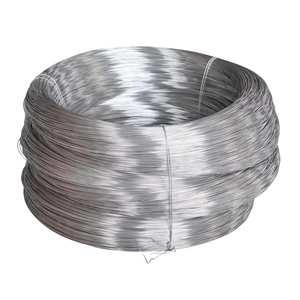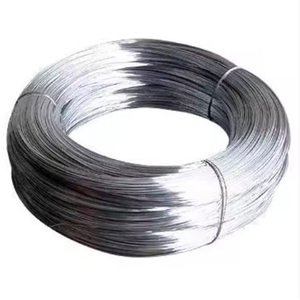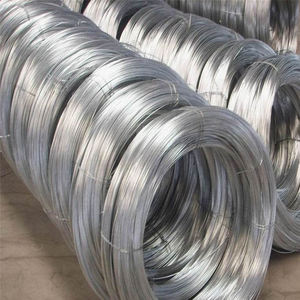
All categories
Featured selections
Trade Assurance
Buyer Central
Help Center
Get the app
Become a supplier

(5103 products available)














































The 12-gauge galvanized wire serves multiple industrial needs. It is a medium-thick wire with considerable strength, suitable for various applications.
These types are based on the manufacturing process, coating method, and the primary metal or alloy composition incorporated within.
Galvanized steel wire
Galvanized steel wire involves the procedure of applying a zinc coating over the steel wire. This act of coating provides defense against corrosion. This kind of wire is commonly applied in outdoor settings or positions prone to dampness, where rust has the propensity to be a serious issue. While the galvanized coat supplies outstanding protection against rust, its finish may be less slippery compared to wires with other kinds of coating. Therefore, it is a preferred option in silos, storage tanks, and outdoor structures requiring durability and low maintenance, besides being cost-effective.
Stainless steel wire
To avoid the corrosion of galvanized wire, stainless steel wire could be utilized. Stainless steel wire does not need an external galvanization coat since it is inherently resistant to rust and corrosion due to its composite materials, which include chromium and nickel. It is greasy and provides an extended life cycle in settings where galvanized wire may degrade over time. Though being more expensive than galvanized wire, stainless steel wire is typically preferred in critical medical, food processing, and marine fields. Thus, stainless steel wire takes a hefty cost yet provides an essential benefit through time for crucial uses.
PVC-coated galvanized wire
This kind of wire contains a galvanized core enveloped in polyvinyl chloride (PVC) coating. This envelope provides an auxiliary layer of protection against corrosion alongside enhanced grip and electrical insulation. The wires also come in assorted colors, offering aesthetic functions to security and fencing structures. Their salient benefit is noticeable in settings where exposure to hazardous substances or electrical conduct is available. They are largely applied in vineyards, orchards, and electric fencing as well. Besides, their longevity empowers them to be functional in various outdoor places.
Copper-coated galvanized wire
Copper-coated galvanized wire includes a layer of copper over a zinc-coated galvanized wire. The resultant wire amalgamates the corrosion resistance of galvanized wire with the electrical conductance of copper. High resistance of copper to corrosion makes this wire suitable for areas where galvanized wire might corrosion due to specific or high-humidity environments. While its enhancement of electrical properties gives it the ability to act as a low-cost substitute for pure copper wiring in some situations, it may not be as corrosion-resistant as stainless steel, making it ideal for some agricultural applications.
Variegated industrial sectors use the galvanized steel wire 12 gauge to utilize its versatility and strength. Galvanization wire has wide application due to its ability to prevent corrosion because of extensive outdoor and industrial use.
Agriculture and farming
Due to its tensile strength and ability to avoid corrosion, the wire is a staple in the agricultural field. Farmers use it for fencing to contain livestock and mark boundaries. Farmers prefer use of 12-gauge wire because it is thin enough to be easily worked with yet thick to withstand tensions and weather elements. Moreover, it is extensively used in trellis systems for vine plants and fruit trees providing support and structure for growth.
Construction and building
12-gauge galvanized wire, available in a roll, is greatly used in the construction business. It is usually used in concrete reinforcement, where it binds rebar together to ensure an even load distribution. In masonry work, it provides support for plaster and stucco finishes. Besides, the wire is a common material in building fences, wire mesh, and barbed wire, effectively combining durability with low maintenance.
Manufacturing and fabrication
The construction portrays such resilience that it can be used in different manufacturing processes. Generally, galvanized iron wire is often employed in the making of mesh, use of filters, and for protective grilles. Galvanized wire is also widely used in product assembly for hanging and suspension of components. Therefore, the 12-gauge wire is suitably thick in terms of providing strength while light in weight.
Horticulture
12 gauge wire supports plants in horticulture, including garden and landscape, due to its mildew and rust resistance. Gardeners use the wire in creating trellises for climbing plants, such as beans and peas. In addition, it makes decorative items like arbors and plant supports. The durability and flexibility of the wire allow easy manipulation; thus, it is straightforward to create different shapes and designs.
Transport and logistics
12-gauge galvanized wire has a prevalence in stringing wire ropes and cables in several transportation means. It is widely used in the construction of fences along highways and railways, contributing to safety and control of erosion. Due to its adaptability, it serves as an important input in many transportation infrastructure, thus ensuring integrity and reliability.
The 12-gauge galvanized steel wire has multiple features and specifications making it valuable in many functions.
Wire diameter
Galvanized wire has a diameter of 0.0808 inches or 2.95 mm. The thickness provides a proper balance between flexibility and strength.
Tensile strength
The wire comes with a tensile strength of 1200 to 1500 psi. This high strength is good to withstand great pressure before it ultimately breaks.
Galvanization coating
The wire is coated with a layer of zinc ensuring protection against corrosion. This zinc layer is approximately 0.0005 to 0.0010 inches thick. The type of galvanization is most Victorian when used outdoors or in humid conditions.
Material composition
The wire is typically made of low-carbon steel. Low-carbon steel is thus easily drawn into fine wire without losing elasticity.
Preparing the workspace
The first move in working with the wire is organizing the workspace, which includes gathering the wire-cutting tools, gloves, and protective gear to avoid injuries during working. The working area must be free of any obstacles hampering ease of movement or wire manipulation.
Cutting the wire
The wire may be cut to the requested length using wire cutters or a hacksaw. Customizing the wire to length allows convenience during fencing application or when doing plant support to achieve the desired dimension.
Handling the wire
Wearing gloves during handling of the wire helps avoid cuts from sharp wire ends. The wire needs to be properly rolled out without tangling to carry out easier manipulation during installation.
Tensioning and securing
If used for fencing, the wire must be pulled taut between fence posts. Posts must then be wrapped or secured using staples or wire ties. A tensioning device may be utilized to ensure even tension.
Routine inspection
To enhance longevity, it is good to carry out regular inspections for signs of wear or rust as fences or plant supports. Identifying issues with wires early enough allows proactive measures in addressing them before they affect functionality.
Cleaning
The wire should be cleaned on a regular basis to get rid of debris and dirt. A pure cloth or brush may be used for cleaning without damaging the galvanized coating. Avoid using sharp objects that may scratch the surface and expose the wire to rust.
Rust prevention
Apart from the galvanized coating which affords a level of rust prevention, applying a rust-resistant spray may benefit old wires. This probably helps vintage wires or those exposed to saltwater or acidic soil, conditions leading to accelerated rusting.
Wire tension adjustment
For fencing uses, loose wires may require re-tensioning. Re-tensioning of the wire ensures maintained security and integrity of the fence. Also, periodic adjustments help avoid sagging and the resultant imbalance of the fence line.
Repairs
Damages such as tears or breaks calls for prompt action. Small breaks may be combined using wire splice or twist ties together. However, for more damage or wear out, replacement length wire is recommended.
Multiple parties have a vested interest in product quality and safety, particularly for a product such as 12-gauge galvanized wire, which has diverse uses in construction, security, agriculture, and more.
Wire gauge precision
The wire needs to be uniform throughout in thickness. Any changes in wire diameter can affect load-carrying capacity, inducing wire failure when most needed.
Galvanization quality
12-galvanization wire should employ a zinc coating of proper thickness. Any coating that is too thin or uneven leads to corrosion, primarily when used in outdoor or humid settings. One measure to this effect is adherence to ISO or ASTM standards for galvanization thickness and coating methods.
Material integrity
12-gauge galvanized wire comes corded from low-carbon steel. It needs to have undergone appropriate tensile tests to guarantee it is devoid of internal defects that may compromise its structural integrity. Often, materials with air bubbles or impurities within them break down faster and put the users in danger.
Coating uniformity
The wire must be inspected for the evenness of the zinc coating. In cases of uneven coatings, exposure to elements may make some areas prone to rust. Users may carry out simple visual checks for signs of bare metal areas showing through the coating.
Corrosion resistance
The wire is intended for long-term outdoor uses across various weather elements. It is corrosion-resistant; hence, maintenance of standard practices is key. Using wires with uneven or worn-out coatings directly can lead to accidents and structural failures.
UV resistance
If PVC-coated wire is used, the wire has to meet standards regarding UV rays resistance. Prolonged exposure may degrade such coatings if the wire is intended for use in contexts exposed frequently to sunlight, such as agriculture and construction.
Mechanical properties
The wire must be flexible yet sturdy enough to avoid breaking under stress. This quality is particularly practical when heavy loads are to be supported or when the wire is subjected to bending during installation.
Sharp edges
While cutting or handling wire ends, sharp edges likely pose a risk of cuts or punctures. It is advisable to cover or bend exposed wire ends to prevent injury to people and livestock around.
Environmental impact
Galvanization comes with environmental costs due to hazardous substances employed in the coating process. Adopt responsible disposal of the wire when it is at the end of its lifetime, as well as any remnants of coatings to minimize soil and water contamination.
Due to its strength, flexibility, and corrosion resistance for outdoor use, 12-gauge wire is suitable for diverse applications.
The wire is capable of withstanding varying temperatures. It remains hardy in extremely high or low temperatures without losing its flexibility or tensile strength.
The wire typically survives up to 10–20 years, depending on environmental factors like humidity, exposure to salt air, and proper maintenance routines.
Coating materials, especially those containing cyanide or heavy metals, negatively impact the environment. Proper disposal of the wire minimizes its impact.
Wire gauge refers to the wire thickness measurement, while wire diameter is the actual physical measurement of the wire's width in millimeters or inches.